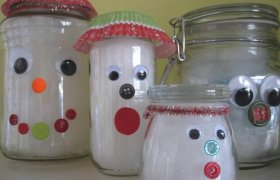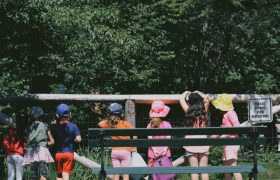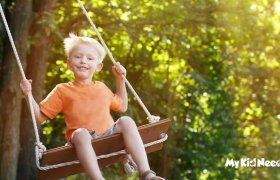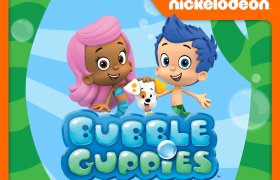10 Unique Show and Tell Ideas for Kids

Show and tell activities are an important exercise for preschoolers and school age children to develop their oral presentation skills, enhance their social skills, and help improve their self-esteem which can facilitate the development of a healthier self-concept, self-worth, and self-confidence. While different parents have different views on the importance of show and tell activities, they all agree on one thing – it is often a nerve-wracking yet truly exciting experience as children get to think creatively, out-of-the-box, and invite everyone else in the classroom to share in their own little world, even for about a minute or two. For parents who have kids in this stage of their lives, it is critical to support them with as many interesting and unique ideas as possible. And if you’ve run out of concepts, we’ve prepared something for you and your kid. Here are 10 unique show and tell ideas for kids to present in class.
Memory Jars
Every kid has very fond memories of his or her childhood. It can be a trip to grandma’s house in the farm or perhaps a weekend camping by the riverside. Or, it could even be as simple as flying a kite on a windy day and having dad prop them on his shoulder so they could easily control their kite. These actually don’t have to be immortalized in pictures. What you can do is to ask your child to think of the many wonderful memories that he or she has. Now, give your child a jar or several small jars to put items that are related to the wonderful memory. For example, if your son really loved fishing with dad, he can place inside the jar a drawing or even a picture of a fish, a real fish hook, and even a section of a fishing line. This way, he will remember that particular moment when he caught his very first fish. And this can help put more realism to the show and tell activity.
Photo Reportage
Kids today are very prolific when it comes to technology. For sure, your kid may already have a kiddie camera if not a smartphone that he or she has used to snap pictures of things that are quite interesting to him or her. You can have these pictures printed and placed in a scrapbook or even in a flip chart. Your kid can then make a ‘report’ of what the picture is all about. He or she might even share the feelings your child may have had at the time of taking the picture. It is also possible to let your child choose a picture or a poster that he or she loves best and use this as a talking point in his or her show and tell.
Scrapbook of Maps
Traveling has never been this easy. Countries are easing their travel restrictions and are now opening their borders to a lot of foreign tourists. And even if your kid has not traveled abroad, he or she may have already visited a place other than yours. You can help your child collect maps of the places where you have visited or even passed through. Your kid will have to recall as much detail about the trip, though, to make the map-sharing experience a really memorable one. The great thing about making a scrapbook of maps is your kid gets to invite classmates and friends to ‘feel’ and ‘experience’ the joys of traveling even if they haven’t been to those places your kid has already been to.
Nature Walk
Mother Nature has a lot of beautiful and inspiring things to offer. Enjoying a nature walk with your kids can bring a host of benefits for them. They get to enjoy nature in its full splendor. They also get to breathe fresh air and appreciate everything else that the city simply lacks – wildlife, flowers, fresh air, rocks, trees, and many more. You can go on one of these trips and collect small items such as dried flowers, broken off twigs, and even loose feathers from birds. You can then help your child craft jewelry that incorporates these items. It can be a bracelet, a necklace, or even a ring. You will also have to be as creative in using these nature walk mementos as important elements to the jewelry that you are crafting. He or she can then show these jewelries in class and share the wonderful story behind each item.
Collage of Leaf Alphabet
Forget the usual alphabet flash cards that teachers use today to teach kids. Instead, head to the garden or your backyard and collect some dried leaves. If you don’t have a backyard, you can always go to the park and ask the park supervisor if you can collect as many dried tree leaves as you can. Assist your child in making individual letter boards that depict an image that begins with that letter. The image should be designed with the dried leaves that you have collected. Complete the alphabet and your child should have a very interesting idea to share in class. Maybe his or her teachers might even adopt the project for other kids to complete.
Diorama of the Ocean
This project might not suit everyone so you may need to think of an alternative to the ocean. The idea is to showcase the splendor of the ocean – seashells, marine life, aquatic plants, etc. If you can get hold of a large bivalve mollusk, you can turn this as both the background and base of your kid’s diorama. Be prepared to get some sand from the beach and complete it with a few other details that talk about the things that you see in the ocean and other bodies of water. The idea is to create a fascinating and truly compelling story in each seashell diorama so that other kids will also learn. For those who are far from the shores and may have never seen an ocean before, you may have to think about other bodies of water and the equally exciting ecosystem that thrives in these areas.
Bears Made of Seashells
It is quite a rare meeting a kid who doesn’t like a teddy bear. They’re cute, furry, and really adorable. And while the Grizzly, Brown, and Black bears are known for their raw power and fearsome reputation, there are other bears that are more docile. For this project, you will need empty seashells which you will use to design a koala or even a panda. To help your child, you may need to obtain a picture of what a koala or a panda looks like so he or she will have an idea on how to arrange the seashells. Also, you will need to supply your kid with art materials to put finishing touches to his or her koala or panda.
Stone Crafts
Get several round-shaped yet flat pebbles or really small stones of increasing or decreasing size. Give your child painting materials and tools to create a ladybug design out of these pebbles. Now, lay out the stone ‘ladybugs’ in a line as if they are following one another on a large leaf. If you cannot get your hands on a large leaf, you can make a leaf cutout from a green construction paper. The image your child is trying to show and tell is that of a group of ladybugs marching from the base of a leaf all the way to its tip in search of their favorite food – aphids. Your child can then share with the class how ecologically important these bugs are as they eat insects that destroy crops.
Treasure Boxes
When people talk about treasures, it can mean a lot of things like gold bars, jewelry, pearls, and even ancient artifacts. For kids, these can be small trinkets and other stuff that adults won’t even consider as anything valuable. It can be their favorite trading card, a baseball, a teddy bear, a stuffed doll, or anything else that a child ‘values’. Making a treasure box is easy. You only need an empty shoebox and several pieces of paper. Paste the opposing ends of the paper to make one continuous sheet. Now fold it like an accordion and paste one end to the bottom of the shoebox and the other end of the paper to the underside of the shoebox cover. Take a picture of your child’s ‘treasures’ and paste them on each folded page. When your kid opens the lid, he or she will be treated to an accordion of personal treasures.
Mini Stories within a Book
To make books within a book you will need a large photo album and several pieces of tickler or pocket notebooks. Your child will write his or her favorite stories in each of these pocket-sized notebooks. You will then help your kid glue the back cover of these ‘mini-books’ onto the pages of the album. One page should hold about 3 to 4 mini books, depending on the size that you’ll use. Your child can then share these stories in class.
There are plenty of ideas for a unique show and tell activity. The point is to look around you and try to create a fascinating story out of it. You don’t even have to go outside your home. All the things your kid need are right inside.







